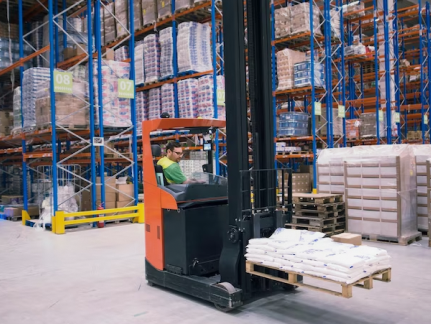As the logistics industry changes, third-party logistics providers adapt by expanding their warehousing space. They are opening new and state-of-the-art warehouse facilities across the country to optimize supply chains and meet the evolving demands of the industry.
The Multifaceted Driving Forces Behind the Shift in the Warehousing Industry
- Online Retail Surge: E-commerce growth has driven demand for efficient warehousing and fulfillment services. 3PL providers are expanding warehouses to meet online order surges and ensure fast, reliable deliveries.
- Supply Chain Resilience: The COVID-19 pandemic highlighted the need for resilient supply chains. 3PL companies are investing in modern warehouses to enhance agility and minimize disruptions.
- Technological Advancements: The warehousing industry has been revolutionized by industry technologies such as automation, robotics, and data analytics. These technologies enable 3PL providers to optimize inventory management, reduce manual errors, and increase operational efficiency.
- Consumer Expectations: Consumers today have higher expectations for fast and accurate deliveries, putting pressure on warehouses to implement efficient and responsive supply chain management.
- Globalization: Expanding the global marketplace requires extensive warehousing networks to support international distribution.
- Sustainability Initiatives: Companies are investing in eco-friendly technologies and energy-efficient infrastructure to reduce their carbon footprint, driven by environmental concerns within the warehousing industry.
- Data Analytics: Big data and analytics optimize warehouse operations by anticipating demand fluctuations and streamlining inventory management.
- Urbanization: The growth of urban areas has led to the development of smaller warehouses located strategically to support last-mile delivery services, resulting in reduced transportation costs and faster deliveries.
- Regulatory Changes: Evolving regulations and trade policies are affecting warehouse operations, requiring businesses to remain adaptable to changing regulatory requirements.
- Labor Challenges: Labor shortages and rising labor costs in certain areas are driving the adoption of automation and robotics in warehouses, making them more self-sufficient.
- Security Concerns: Warehouses invest in security measures to protect sensitive data and ensure business continuity amidst rising cyber threats and supply chain disruptions.
A reliable Warehouse Management System (WMS) can transform third-party logistics (3PL) operations. It streamlines warehouse management and offers several benefits that can boost the success and competitiveness of a 3PL provider. These benefits include improved inventory accuracy, better order fulfillment, enhanced labor productivity, optimized warehouse space, and reduced operating costs.
- Improved Efficiency: A WMS automates tasks such as order processing, inventory tracking, and order picking, reducing errors and increasing productivity. This leads to faster order fulfillment and shorter lead times, resulting in a more efficient warehouse environment.
- Enhanced Accuracy: WMS systems are equipped with advanced features like barcode scanning and RFID technology, significantly reducing errors in picking, packing, and shipping, leading to higher order accuracy and customer satisfaction. This, in turn, reduces costly returns and re-shipments.
- Real-Time Visibility: A warehouse management system (WMS) provides accurate real-time visibility into inventory and order statuses. This allows third-party logistics (3PL) providers to monitor better stock levels, track orders, and manage replenishments while also enabling better decision-making with accurate data and insights.
- Optimized Space Utilization: Third-party logistics providers can maximize storage space by using WMS software to suggest optimal item bin locations, thereby reducing the need for additional storage facilities.
- Flexible Scalability: As 3PL providers expand, their warehouse needs change. A good WMS can scale with the business, accommodating growth and new clients without disruptions.
- Streamlined Compliance: WMS systems assist 3PLs in complying with industry regulations, especially in highly regulated sectors like pharmaceuticals and food distribution.
- Labor Optimization: By automating and optimizing warehouse tasks, WMS can help 3PLs better use their labor resources by ensuring that workers are assigned tasks that match their skills and maximize productivity.
- Client Satisfaction: A well-implemented WMS can lead to faster order processing, more accurate deliveries, and improved client communication, ultimately resulting in higher client satisfaction and loyalty.
- Cost Savings: Implementing a WMS can lead to significant cost savings for 3PLs by improving operational efficiencies, reducing errors, and optimizing space utilization. This includes savings on labor and storage costs as well as a reduction in waste.
- Competitive Advantage: A robust WMS gives 3PL providers a competitive edge by enabling them to offer faster, more accurate, and cost-effective services. This helps them attract and retain clients in a highly competitive industry.
A Warehouse Management System (WMS) can significantly transform the operations of third-party logistics providers (3PLs). With a WMS in place, 3PLs can enhance their efficiency and accuracy in managing warehouse operations. Additionally, the system provides real-time visibility of inventory and order processing, which can help in making informed decisions and improving customer service. The scalability of WMS also allows 3PLs to handle more complex operations and accommodate growth without significant changes to the system. Lastly, a WMS can help 3PLs reduce costs by optimizing inventory management and reducing errors. Overall, implementing a WMS can give 3PLs a competitive edge in a constantly evolving industry.
